 |
 |
 |
| |
Pegasys 270 ug/wk+RBV 1200/1600mg in Difficult To Treat Patients
|
| |
| |
Reported by Jules Levin
AASLD, Oct 27-31, 2006, Boston, MA
"Improved sustained virological response (SVR) rates with higher, fixed doses of peginterferon alfa-2a (40KD) (PEGASYS) plus ribavirin (COPEGUS) in patients with 'difficult-to-cure' characteristics"
M.W. Fried,1 D. Jensen,2 M. Rodriguez-Torres,3 L. Nyberg,4 A.M. Di Bisceglie,5 T. Morgan,6 P. Pockros,7 A. Lin,8 L. Cupelli,8 D. Nelson9
1University of North Carolina, Chapel Hill, NC, USA; 2University of Chicago, Chicago, IL, USA; 3Fundacion de Investigacion De Diego Santurce, Santurce, Puerto Rico; 4Kaiser Permanente Medical Center, San Diego, CA, USA;
5St Louis University Gastroenterology, St Louis, MO, USA; 6Veterans Administration Medical Center, Long Beach, CA, USA; 7Scripps Clinic, La Jolla, CA, USA; 8Roche, Nutley, NJ, USA.; 9University of Florida, Gainesville, FL, USA
INTRODUCTION
The standard treatment for patients with chronic hepatitis C is the combination of a pegylated interferon plus ribavirin. Such treatment has yielded overall sustained virologic response (SVR) rates of 54-63% in randomized, controlled, phase III clinical trials.[1-3]
However, treatment responses are not uniform across all populations[4] and are dependent on various viral and patient characteristics.
Genotype and baseline hepatitis C virus (HCV) RNA levels are the most important predictors of response; patients with HCV genotype 1 and high levels of HCV RNA (>800 000 IU/mL) have lower rates of SVR.
Furthermore, 'difficult-to-cure' features, such as HCV genotype 1, high baseline viral level, increased bodyweight and the presence of cirrhosis, tend to cluster together, which further worsens the prognosis.[5] Strategies to improve SVR rates using currently available medications in this 'difficult-to-cure' population are urgently needed.
OBJECTIVE
The aim of this study was to determine whether intensification of treatment using high fixed doses of peginterferon alfa-2a (40KD) (PEGASYS) (270 _g/week) and ribavirin (COPEGUS) (1600 mg/day) improves virologic response rates in patients with 'difficult-to-cure' characteristics.
AUTHOR CONCLUSIONS
The use of higher fixed doses of peginterferon alfa-2a (40KD) (PEGASYS) (270 ug/week) and ribavirin (COPEGUS) (1600 mg/day) increased SVR rates compared with standard doses of both drugs (47% vs 28%) in patients with a
cluster of 'difficult-to-cure' characteristics (HCV genotype 1, high baseline
HCV RNA levels and bodyweight >85 kg).
The use of higher doses of peginterferon alfa-2a (40KD) and ribavirin was associated with a trend towards an increase in the rate of serious adverse events, compared with standard doses.
The improvement in SVR rates resulted from lower relapse rates in patients treated with the most intense regimen. Increasing the dose of ribavirin alone or the dose of peginterferon alfa-2a (40KD) alone did not reduce relapse or improve SVR rates.
The results of this pilot study are compelling, and have influenced the design of
a large randomized international trial (PROGRESS).
METHODS
Patients
Treatment-naive adults with a bodyweight >85 kg with chronic hepatitis C genotype 1 infection and a baseline HCV RNA level >800 000 IU/mL determined by quantitative polymerase chain reaction (PCR) assay (COBAS AMPLICOR HCV MONITOR Test, v2.0) were eligible for inclusion.
Study design
In this randomized, double-blind, parallel-group pilot study, patients received
48 weeks' treatment with peginterferon alfa-2a (40KD) 180 _g/week or
270 _g/week plus ribavirin 1200 or 1600 mg/day as follows:
- peginterferon alfa-2a (40KD) 180 _g/week plus ribavirin 1200 mg/day
(Group A)
- peginterferon alfa-2a (40KD) 180 _g/week plus ribavirin 1600 mg/day
(Group B)
- peginterferon alfa-2a (40KD) 270 _g/week plus ribavirin 1200 mg/day
(Group C)
- peginterferon alfa-2a (40KD) 270 _g/week plus ribavirin 1600 mg/day
(Group D).
Assessments and statistical analysis
The primary measure of efficacy was a reduction in HCV RNA level from baseline to week 24. A repeated measures, linear, mixed effects analysis of covariance was used to compare the HCV RNA profile between treatment arms over the first 24 weeks of treatment. HCV RNA values were log10 transformed.
SVR, a secondary end-point, was measured in all patients who received at
least one dose of study drug. SVR was defined as undetectable serum HCV RNA (COBAS AMPLICOR HCV Test, v2.0; limit of detection 50 IU/mL) at the end of the 24-week follow-up period (week 72).
Other end-points included the proportion of patients with undetectable HCV RNA at 4 weeks (rapid virologic response; RVR), 12 weeks, 24 weeks and 48 weeks (treatment end).
Dose modifications of peginterferon alfa-2a (40KD) and ribavirin for adverse events and laboratory abnormalities were allowed in a stepwise manner
that maintained blinding.
Safety was assessed by physical examination, laboratory tests, and spontaneous reports of clinical adverse events.
RESULTS
In total, 188 patients were randomly assigned to treatment, and follow-up data were available for 143 (76%) of these. One patient randomized to group A never received study medication.
Baseline characteristics of patients across the four treatment groups were
similar (Table 1).
Table 1. Patient characteristics at baseline (data presented as mean
± standard deviation [SD] unless otherwise stated)
Mean bodyweight was 97 to 101 kg, that's 200 to 230 lbs, heavy. Bocy mass index (BMI) was 31.7 to 33.3 kg/m2, big. 9-13% were Black, 62-74% Caucasian. Mean HCV RNA was 4.9 to 6.2 logs. 17-19% had cirrhosis.
Group A: Peginterferon alfa-2a (40KD) 180 _g/week plus ribavirin 1200 mg/day (n=46).
Group B: Peginterferon alfa-2a (40KD) 180 _g/week plus ribavirin 1600 mg/day (n=47).
Group C: Peginterferon alfa-2a (40KD) 270 _g/week plus ribavirin 1200 mg/day (n=47).
Group D: Peginterferon alfa-2a (40KD) 270 _g/week plus ribavirin 1600 mg/day (n=47).
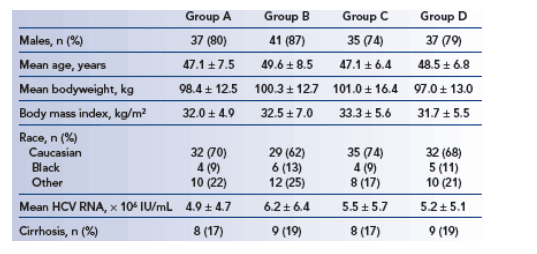
Efficacy
Viral kinetics
A peginterferon alfa-2a (40KD) dose of 270 _g/week was associated with a larger reduction in the predicted viral load over the first 24 weeks of treatment, compared with a peginterferon alfa-2a (40KD) dose of 180 _g/week, regardless of histologic diagnosis.
- the greater reduction in predicted viral load with peginterferon alfa-2a (40KD) 270 _g/week vs peginterferon alfa-2a (40KD) 180 _g/week was significant in patients receiving ribavirin 1600 mg/day (p=0.036), and approached significance in patients receiving ribavirin 1200 mg/day (p=0.061) (Figure 1).
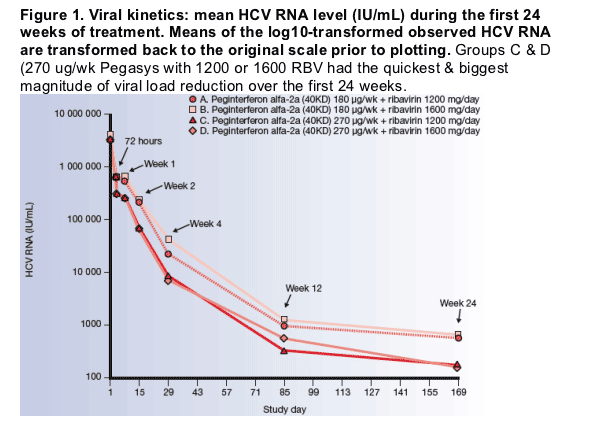
Ribavirin did not appear to influence HCV RNA levels throughout the treatment period in either of the groups receiving peginterferon alfa-2a (40KD) 270 _g/week or peginterferon alfa-2a (40KD) 180 _g/week (Figure 1). Both did equally well.
Virologic response
The proportion of patients with an RVR was increased in the experimental intensification arms (groups B-D), compared with the standard-dose arm (Group A) (Figure 2).
In contrast, the proportion of patients with undetectable HCV RNA at week 12 was generally similar across groups A-D (Figure 2).
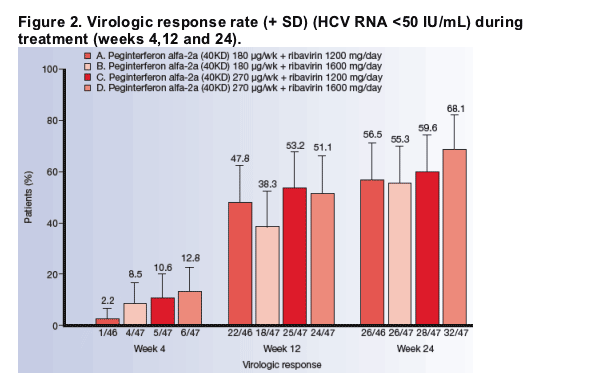
The highest rate of virologic response after 24 weeks' treatment was observed in those patients treated with the most intensive treatment regimen (peginterferon alfa-2a [40KD] 270 ug/week plus ribavirin 1600 mg/day, group D). In the other three groups, virologic response rates were somewhat lower and similar (Figure 2).
The rate of SVR in patients receiving the most intensive regimen (peginterferon alfa-2a [40KD] 270u_g/week plus ribavirin 1600 mg/day, group D) was higher than that in patients receiving the standard-dose regimen (group A) (Figure 3) (46.8% [95% CI 32.5-61.1%] vs 28.3% [95% CI 15.3-41.3%], respectively).
Due to small sample sizes, these confidence intervals overlapped. However, the SVR rate for group A fell below the lower 95% CI for group D.
Among groups A, B and C, respectively, the relapse rates between week 48 and week 72 were 40% (8/20), 42% (11/26), and 46% (12/26). In comparison, the relapse rate in patients treated with the most intensive regimen (group D) was only 19% (5/26). Thus, treatment intensification was associated with a >50% relative reduction in the rate of relapse, compared with the standard regimen.
Safety
The adverse event profile was similar to that previously reported in patients treated with the combination of peginterferon alfa-2a (40KD) plus ribavirin.
The use of higher doses of peginterferon alfa-2a (40KD) and ribavirin was associated with a trend towards an increased rate of serious adverse events, compared with standard doses (11-13% vs 9%), although patient numbers were small.
Compared with standard doses of peginterferon alfa-2a (40KD) and ribavirin, the peginterferon alfa-2a (40KD) 270 _g/week plus ribavirin 1600 mg/day regimen was associated with an increased incidence of some hematologic laboratory abnormalities (Table 2).
Increased dose modifications for laboratory abnormalities and adverse events, and premature withdrawals for safety reasons were also observed with the peginterferon alfa-2a (40KD) 270 ug/week plus ribavirin 1600 mg/day regimen, compared with the standard regimen (Table 2).
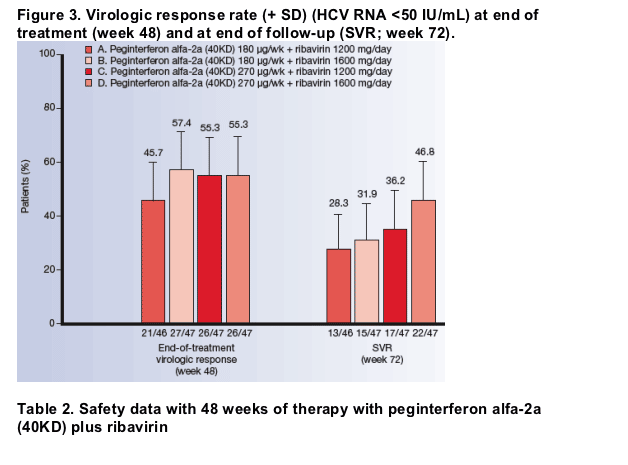
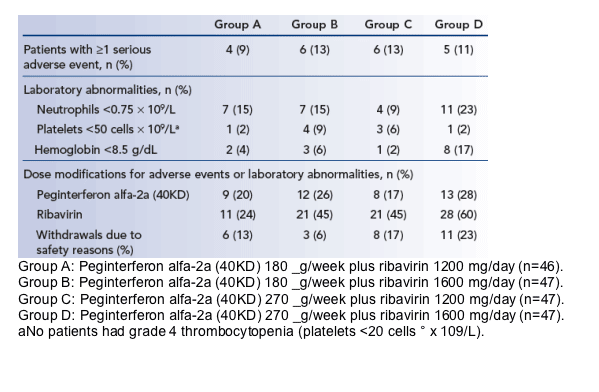
|
| |
|
 |
 |
|
|